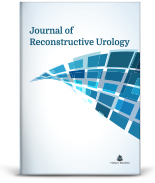Böbrek tümörleri, ürolojik kanserler içinde üçüncü sıklıkla gözlenir. Renal hücreli karsinom, böbreğin en sık görülen kanseridir. Renal hücreli kanserler %40'ın üzerindeki ölüm oranı ile mortalitesi en yüksek ürolojik kanserdir. Uzun yıllar boyunca radikal nefrektomi, tüm böbrek tümörlerinin tedavisinde standart seçenek olarak uygulanmıştır. Ancak son 20 yıllık dönemde, böbrek tümörü cerrahisinde daha az invaziv ya da nefron koruyucu yöntemler tercih edilmeye başlanmıştır. Uygun hastalarda, radyofrekans ablasyon ve kriyoablasyon gibi minimal invaziv tedavi yöntemleri tercih edilebilir. Radyofrekans ablasyon sonrası lokal nüks olmaksızın uzak metastaz çeşitli yayınlarda %1-2 olarak bildirilmiştir. Kas dokusu nadir metastaz yaptığı bölgelerden biridir. Bu çalışmada, literatür eşliğinde soliter böbrekteki renal hücreli karsinoma uygulanan radyofrekans ablasyon sonrası nadir görülen uzak metastazı ve yaklaşımımızı anlattık.
Anahtar Kelimeler: Renal hücreli karsinom; radyofrekans ablasyon; metastaz
Renal tumors are the third most common urologic cancer. Renal cell carcinoma is the most common cancer of the kidney. Renal cell cancers have the highest mortality rate with a mortality rate of over 40%. For many years, radical nephrectomy has been used as a standard option in the treatment of all renal tumors. However, in the last 20 years, less invasive or nephron-sparing methods have been preferred in renal tumor surgery. Minimally invasive treatment modalities such as radiofrequency ablation and cryoablation may be preferred in suitable patients. Distant metastasis without local recurrence after radiofrequency ablation has been reported to be 1-2% in variouspublications. Muscle tissue is one of the rare metastatic sites. In this article, we describe our rare approach to distant metastasis after radiofrequency ablation of renal cell carcinoma in the solitary kidney.
Keywords: Renal cell carcinoma; radiofrequency ablation; metastasis
- European Network of Cancer Registries: EUROCIM version 4.0. 2001. European Incidende Database V.2.3. ICD-10 Dictionary (2001). Lyon: International Association for Research on Cancer, 2001.
- Campbell SC, Lane BR. Malignant renal tumors. In: Wein AJ, Kavoussi LR, Novick AC, Partin AW, Peters CA, eds. Campbell-Walsh Urology. 10th ed. Philadelphia: Saunders-Elsevier; 2011. p.1413-74.
- Kantor AF. Current concepts in the epidemiology and etiology of primary renal cell carcinoma. J Urol. 1977;117(4):415-7. [Crossref]
- King SC, Pollack LA, Li J, King JB, Master VA. Continued increase in incidence of renal cell carcinoma, especially in young patients and high grade disease: United States 2001 to 2010. J Urol. 2014;191(6):1665-70. [Crossref] [PubMed] [PMC]
- Matin SF, Gill IS, Worley S, Novick AC. Outcome of laparoscopic radical and open partial nephrectomy for the sporadic 4 cm. or less renal tumor with a normal contralateral kidney. J Urol. 2002;168(4 Pt 1):1356-9.
- Chawla SN, Crispen PL, Hanlon AL, Greenberg RE, Chen DY, Uzzo RG. The natural history of observed enhancing renal masses: meta-analysis and review of the world literature. J Urol. 2006;175(2):425-31. [Crossref]
- Robson CJ. Radical nephrectomy for renal cell carcinoma. J Urol. 1963;89:37-42.
- Johnson BA, Sorokin I, Cadeddu JA. Ten-year outcomes of renal tumor radio frequency ablation. J Urol. 2019;201(2):251-8.
- Stern JM, Svatek R, Park S, Hermann M, Lotan Y, Sagalowsky AI, et al. Intermediate comparison of partial nephrectomy and radiofrequency ablation for clinical T1a renal tumours. BJU Int. 2007;100(2):287-90. [Crossref] [PubMed]
- Arnoux V, Descotes JL, Sengel C, Terrier N, Rambeaud JJ, Long JA. [Perioperative outcomes and mid-term results of radiofrequency ablation and partial nephrectomy in indications of renal tumor treatment and imperative nephron-sparing procedure]. Prog Urol. 2013;23(2):99-104.
- Wunderlich H, Schlichter A, Zermann DH, Reichelt O, Kosmehl H, Schubert J. Multifocality in renal cell carcinoma: a bilateral event? Urol Int. 1999;63(3):160-3. [Crossref] [PubMed]
- Pierorazio PM, Johnson MH, Ball MW, Gorin MA, Trock BJ, Chang P, et al. Five-year analysis of a multi-institutional prospective clinical trial of delayed intervention and surveillance for small renal masses: the DISSRM registry. Eur Urol. 2015;68(3):408-15. [Crossref] [PubMed]
- Gill IS, Remer EM, Hasan WA, Strzempkowski B, Spaliviero M, Steinberg AP, et al. Renal cryoablation: outcome at 3 years. J Urol. 2005;173(6):1903-7. [Crossref] [PubMed]
- Weld KJ, Figenshau RS, Venkatesh R, Bhayani SB, Ames CD, Clayman RV, et al. Laparoscopic cryoablation for small renal masses: three-year follow-up. Urology. 2007;69(3):448-51.
- Weizer AZ, Raj GV, O'Connell M, Robertson CN, Nelson RC, Polascik TJ. Complications after percutaneous radiofrequency ablation of renal tumors. Urology. 2005;66(6):1176-80.
- Kunkle DA, Egleston BL, Uzzo RG. Excise, ablate or observe: the small renal mass dilemma--a meta-analysis and review. J Urol. 2008;179(4):1227-33. [Crossref] [PubMed]
- Lorber G, Glamore M, Doshi M, Jorda M, Morillo-Burgos G, Leveillee RJ. Long-term oncologic outcomes following radiofrequency ablation with real-time temperature monitoring for T1a renal cell cancer. Urol Oncol. 2014;32(7):1017-23. [Crossref] [PubMed]
- Safadi A, Abu Ahmad MS, Sror S, Schwalb S, Katz R. Simultaneous metachronous renal cell carcinoma and skeletal muscle metastasis after radical nephrectomy. Urol Case Rep. 2017;16:17-9. [Crossref] [PubMed] [PMC]
- Abara E, Chivulescu I, Clerk N, Cano P, Goth A. Recurrent renal cell cancer: 10 years or more after nephrectomy. Can Urol Assoc J. 2010;4(2):E45-9. [Crossref] [PubMed]
- Lohiya V, Lohiya S, Windsor K. A large thigh mass: a blood clot or a rare skeletal muscle metastasis from renal cell carcinoma. Springerplus. 2013;2:399. [Crossref] [PubMed] [PMC]







.: Process List